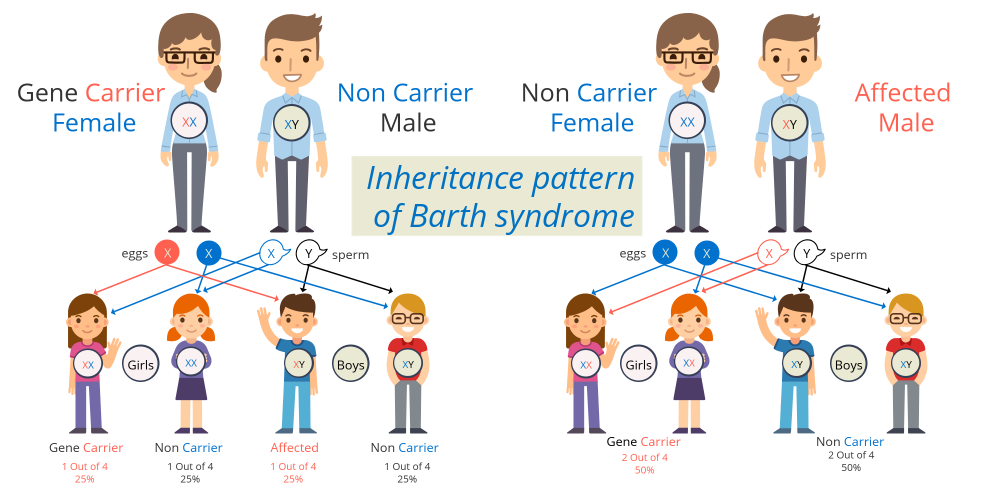Ways a woman becomes a Barth syndrome carrier
- Through her mother, if her mother is a carrier herself
- Through her father, if her father has Barth syndrome
In addition, a NEW genetic mutation might cause the disorder spontaneously, with neither parent possessing or transmitting the change. This is called a de novo mutation.
If a mother is a confirmed carrier, then each of her sons has a 50/50 chance of having Barth syndrome and each of her daughters has a 50/50 chance of being a carrier as well. If the father has Barth syndrome, all his daughters will be carriers and none of his sons will have Barth syndrome.
You are a carrier—now what?
- Being a Barth syndrome carrier can be difficult to understand and accept.
- There is often a feeling of grief, and, even though carriers know that it is not their fault, many have a sense of guilt.
- Some carriers feel isolated and have trouble communicating their feelings to both family and medical professionals.
- It is important to know that there is no right or wrong way to feel, and taking care of your mental health is as important as your physical health. Whether you are dealing with grief, guilt or feeling depressed, having a supportive group to talk to is key, and may include family members, clergy, other individuals in the BSF community, and professional counselors.
- It is important to realize that your emotions and feelings will change over time.
- Whether you discover that you are a carrier before or after you have children can make a difference in how you are able to accept your status, but, in many cases, the decisions that need to be made are the same.
- There is no right or wrong way to approach family planning decisions once a genetic diagnosis has been made in a family. It is a very personal choice to the couple that is influenced by many things including personal experiences with the diagnosis, emotional and financial resources, as well as religious and cultural beliefs. Some families may choose to do nothing or consider adoption, while others might utilize reproductive testing options, preimplantation or prenatal, to help prevent recurrence or to help plan for delivery. Carriers are advised to educate themselves about all options (see family planning options) before making a decision.
Words of wisdom from “veteran” carriers
- You and your significant other will not always be on the same page—as always communication is the key.
- Your feelings will change over time, sometimes on a day-to-day basis.
- It can help to talk about being a carrier, especially with other carriers; they understand and can help normalize it.
- Before telling your daughter that she may be a carrier, make sure that she has the capacity to understand and that she is able to discuss the ramifications.
Testing for Carrier Status
- There are a number of things to take into consideration when making the decision to test for carrier status, and it cannot be stressed enough that only the person taking the test will know when/if she is ready.
- It is important to be aware that knowing you are a carrier can make an impact on relationships—friends, siblings, parents and significant others.
- There may also be a change in your perception of yourself.
- The person needs to ask what it would mean to know and why she is interested in testing.
- It is also a good idea to have a disclosure plan—when and what to tell friends and family.
- In order to be able to perform the test, the exact gene variant (that runs in your family) must already be identified.
- The individual does not need to be 18, but testing must be her own personal choice and decision, not her family’s or friends’. Note that, in general, parents cannot request testing of their minor daughters.
- She should meet and speak with a genetic counselor and/or physician prior to testing.
- The test is a simple blood sample, or sometimes a buccal swab or saliva sample.
- Results are received in two to four weeks, depending on the lab.
Family Planning Options for Carriers
There is a huge spectrum of family planning options open to carriers of a Barth syndrome gene variant (TAZ) who are at risk of passing that mutation on to their children. There is no right or wrong preference, and we recommend that potential parents speak with a genetic counselor and/or therapist before making their decision. Some of the avenues open to families include:
Parents can have a natural pregnancy and accept that there may be a 25% chance that their child will either have Barth syndrome or be a carrier. With this option, no testing is performed before conception, and the couple may either pursue prenatal diagnosis, or they can wait until the child is born, and then, if it is a boy, he can be tested at birth.
If the couple chooses prenatal testing, the first step would most often be a blood test or an ultrasound to determine gender—if it is a girl, no further testing is done. Options to determine gender during a pregnancy include:
- Noninvasive prenatal testing, offered from 10-22 weeks gestation, involves extraction of cell free fetal DNA from the blood of the mother and can be used to determine gender, as well as chromosome number and genetic testing for a small handful of single gene disorders. Unfortunately, it is not currently a reliable option to test a pregnancy for a specific TAZ variant.
- Fetal Ultrasound when done after 18 weeks gestation may be able to determine gender.
If it is a boy, there are two routinely used options for prenatal diagnosis:
- Chorionic villus sampling (CVS), performed between 10-12 weeks of pregnancy, is a procedure in which a sample of chorionic villi is removed from the placenta for genetic testing.
- Amniocentesis, performed at 15-18 weeks of pregnancy, is a procedure in which a sample of amniotic fluid is removed from the amniotic sac for genetic testing.
Both of these options carry a ~1/200 chance risk of miscarriage.
If this prenatal testing reveals that the fetus is affected, the parents have the opportunity to prepare to have a child with Barth syndrome, or have the option of terminating the pregnancy.
In-Vitro Fertilization (IVF) using an egg donor. This reduces the chance of having a child with Barth syndrome down to the same chance as in the regular population.
IVF using Preimplantation Genetic Testing (PGT) combines IVF with genetic testing, with the goal of implanting only unaffected embryos into the mother’s uterus. This method involves taking a cell from each embryo created through IVF and performing genetic testing on them. Unaffected embryos can then be identified, and only those will be transferred to the mother’s uterus. Some centers offer PGT by polar body biopsy which allows only a look at maternal contribution but can often be done just before fertilization.
Adoption, is another option to consider, and there are many private and government agencies available.
Reproductive options and prenatal testing methods are continually evolving and improving. In addition, laws governing availability of various technologies differ by country. Also, these alternatives can be costly and not all options are covered by insurance programs. Therefore, it is extremely important to get all of the current and correct information at the time it is needed.
Reviewer
Rebecca McClellan, MCG, CGC, Genetic Counselor, Johns Hopkins University, Kennedy Krieger Institute
Disclaimer: This fact sheet is designed for educational purposes only and is not intended to serve as medical advice. The information provided here should not be used for diagnosing or treating a health problem or disease. It is not a substitute for professional care.
ADDITIONAL RESOURCES
Videos
- Genetics and Carriers in Barth Syndrome. Colin Steward, PhD, FRCP, FRCPCH, Rebecca L. McClellan, MGC, CGC, Cynthia James, ScM, PhD., Lee Kugelmann, Barth Syndrome Foundation 9th International Scientific, Medical & Family Conference 2018
- From DNA to TAZ variants ...is this a mutation or not? Iris L. Gonzalez, PhD, Barth Syndrome Foundation 9th International Scientific, Medical & Family Conference 2018
- Tips and strategies for talking to your children about genetics. Rebecca L. McClellan, MGC, CGC, Kennedy Krieger Institute, Baltimore, MD; Cynthia James, ScM, PhD, Lee Kugelmann, Barth Syndrome Foundation 9th International Scientific, Medical & Family Conference 2018
- Study update: How do women adapt to being a Barth syndrome carrier? Rebecca L. McClellan, MGC, CGC, Barth Syndrome Foundation 9th International Scientific, Medical & Family Conference 2018
Publications
- Schenk M, Groselj-Strele A, Eberhard K, et al. Impact of polar body biopsy on embryo morphokinetics-back to the roots in preimplantation genetic testing?. J Assist Reprod Genet. 2018;35(8):1521-1528. doi:10.1007/s10815-018-1207-4
- Orstavik KH, Orstavik RE, Naumova AK, et al. X chromosome inactivation in carriers of Barth syndrome. Am J Hum Genet. 1998;63(5):1457-1463. doi:10.1086/302095
- Orstavik KH, Skjörten F, Hellebostad M, Hågå P, Langslet A. Possible X linked congenital mitochondrial cardiomyopathy in three families. J Med Genet. 1993;30(4):269-272. doi:10.1136/jmg.30.4.269
-
Printable Version of Carrier Document





